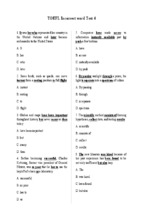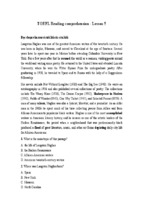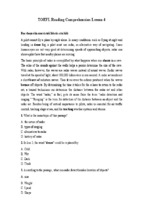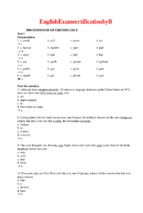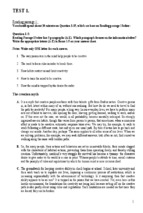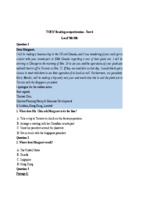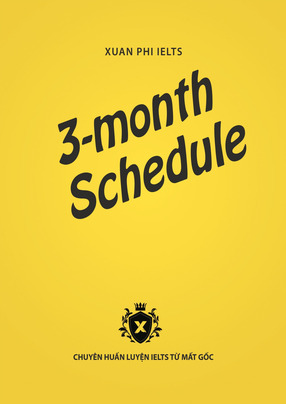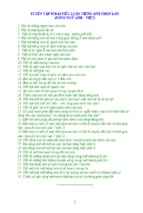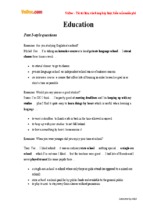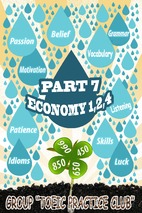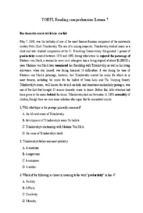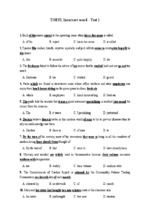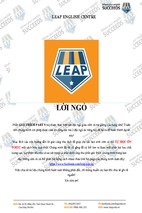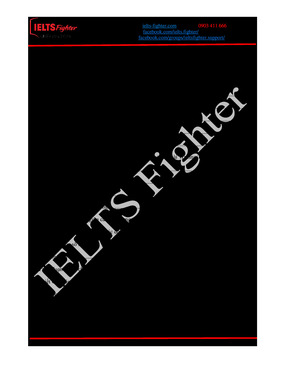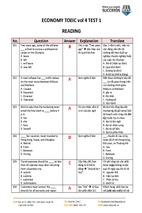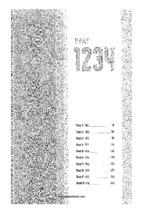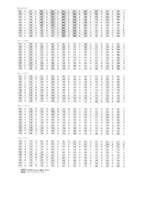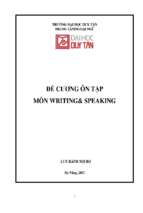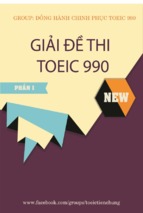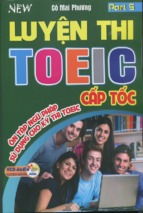7-10
97 年 10 月 TOFEL 听力 (Page 180)
A
1. (A) He doesn't have enough money to buy a printer now.
(B) He's not sure how much a printer costs.
(C) He'll buy a computer later this week.
(D) He lost the money he was saving.
2. (A) Wait to play until after his 9 o'clock class.
(B) Ask Carol to play tennis.
(C) Ask Carol if she's going to class.
(D) Get a tennis lesson from Carol.
3. (A) They should ask for an increase in the budget.
(B) The calculations appear correct to her.
(C) She'll try to see what method was used
(D) They need to make a copy of the budget.
4. (A) He could bring something to the woman
(B) He'd be happy to go with the woman.
(C) He wants the woman to get him a newspaper.
(D) He'd like something to eat.
5. (A) The barbecue has been canceled.
(B) The weather will probably be cool.
(C) The man will not be able to attend the barbecue.
(D) Casual dress will be appropriate.
6. (A) He has had study habits.
(B) He sleeps too much.
(C) He wakes up early.
(D) He's an excellent student.
7. (A) She dislikes fireworks.
(B) She has plans for the evening.
(C) She doesn't feel like going out.
(D) She has to get theater tickets.
8. (A) The library is closed tonight.
(B) He doesn't know how to get to the library.
(C) Jean is using his car.
(D) He won't be able to help the woman.
9. (A) He has received his telephone bill.
(B) His calls weren't listed.
(C) The woman has already paid for her call.
(D) He has received a long distance call.
10. (A) The man should take the stereo back to the store.
(B) The man should refer to the instruction manual.
(C) She'll go to the man's house and help him.
(D) She'll give the man her instruction manual.
11. (A) Candy has been ordered for the machine.
(B) They still have some candy left over.
(C) The machine isn't working right now.
(D) The machine was moved to another building.
12. (A) Discuss a magazine article with the woman.
(B) Help the woman find a new doctor.
(C) Go to the store for some medicine.
(D) Buy the woman some magazines.
13. (A) The plants may need more light.
(B) The plants should get less water.
(C) The area in front of the window is too cold for plants.
(D) Plants rarely do well in the dormitory.
14. (A) The restaurant closes early during the week.
(B) He thought the woman's birthday was next week.
(C) The woman should find out if she can reserve a table.
(D) He won't be able to go with the woman.
15. (A) Find out where their professor is going to perform.
(B) Go to a concert.
(C) Perform in a musical recital.
(D) Interview the violinist.
16. (A) He has to go home to feed pet.
(B) He's expecting Cindy to arrive soon.
(C) He cannot go to Cindy's.
(D) He must keep an appointment with his doctor.
17. (A) Join the dormitory council himself.
(B) Attend the next council.
(C) Persuade the other council members not to quit.
(D) Help the woman find someone to fill the vacancy.
18. (A) The center has just opened.
(B) He's looking forward to using the center.
(C) The door to the fitness center is locked
(D) There are long lines to get into the center.
19. (A) The film committee is full
(B) Being on the committee requires a great deal of
(C) It is difficult to be selected for the committee.
(D) The man needs to sign up another place.
20. (A) Disappointed.
(B) Surprised
(C) Nervous
(D) Uninterested.
21. (A) The weather is usually bad at the picnics.
(B) He'll need a change of clothes for the picnic
(C) He's not looking forward to attending the picnic.
(D) He's looking for a new place to hold the picnic.
22. (A) He agrees that the custodian will have a lot of work to do.
(B) He doesn't want to mess up the clean room.
(C) He wants the woman to speak a little louder.
(D) He doesn't think the woman should talk to the custodian again
23. (A) He usually isn't hungry until lunch time.
(B) His stomach hurts when he eats too fast.
(C) He likes to eat lunch at two o'clock.
(D) He needs to run errands during lunch.
24. (A) He put some notes on the desk last night.
(B) The woman should check with the school
(C) The woman shouldn't have moved his books.
(D) The notebook might be among some other books.
25. (A) Somebody frightened the birds away.
(B) The berries aren't ripe yet.
(C) She doesn't like berries.
(D) The berries aren't good to ear.
26. (A) She thought her hair was too short.
(B) Her new hairstyle is more practical
(C) She cut her hair herself.
(D) She has to tie back her hair.
27. (A) Write his paper on a more general topic.
(B) Take the woman's advice about his paper.
(C) Choose an entirely new topic for his paper.
(D) Retype his paper.
28. (A) She decided not to cancel her appointment.
(B) Her new glasses aren't comfortable.
(C) She's too busy to get a checkup
(D) She has to check when the appointment is.
29. (A) He hadn't noticed any change in Mark.
(B) Mark looks different without a beard.
(C) He thinks Mark looked better with the beard.
(D) He hasn't seen Mark yet.
30. (A) She didn't like the food the man prepared.
(B) She's not a very good cook.
(C) She's annoyed with the man.
(D) She thinks the man spent too much time cooking.
31. (A) She's waiting for her father.
(B) She's having her bicycle repaired.
(C) She wanted to surprise John.
(D) She works there.
32. (A) To replace his stolen bicycle.
(B) To begin bicycling to work.
(C) To join a bicycle club.
(D) To train for a bicycle race.
33. (A) Buy a used bicycle.
(B) Buy a racing bicycle.
(C) Replace the tires on his bicycle.
(D) Sell his old bicycle to the shop.
34. (A) It must be the right height.
(B) It must have several gears.
(C) It must have good tires.
(D) It must be the right weight.
35. (A) On television.
(B) At registration
(C) In class.
(D) At work.
36. (A) Students are not required to attend regular class lectures.
(B) The professor videotapes class lectures for review.
(C) Classes are held at various locations throughout the area.
(D) Students receive credit for work experience.
37. (A) It allows them to meet students from other universities.
(B) It promotes the concept of self-learning.
(C) It allows more flexibility in students' schedule.
(D) It doesn't require any examinations.
38. (A) It's a requirement for psychology majors.
(B) She wasn't able to get into the traditional course.
(C) She lives far from the university.
(D) She has to work a lot of hours this semester.
39. (A) It requires too much traveling.
(B) It limits interaction among students.
(C) It will increase class size.
(D) It will encourage students to watch too much television.
40. (A) He was well known on the West Coast.
(B) He served as James Polk's Vice President.
(C) He supported financial aid to farmers.
(D) He was a popular war hero.
41. (A) He was not interested in political reform
(B) He had an unusual military career.
(C) He had no political experience.
(D) He expressed many controversial ideas.
42. (A) He lost the support of farmers.
(B) He was opposed by the Whig party.
(C) He died early in his term.
(D) He came into conflict with railroad owners.
43. (A) Listen to a talk about another President.
(B) Write a report about Taylor's accomplishments
(C) Discuss the differences between Polk and Taylor.
(D) Begin working on their reports about Vice President.
44. (A) To commemorate a historic flight.
(B) To try out eighty new balloons.
(C) To recruit balloonists from all over the United States.
(D) To determine whether helium balloons are better than hot-air balloons.
45. (A) They may not be able to inflate their balloons.
(B) There are too many balloons to launch at once.
(C) Their flight pattern could be uncertain due to the wind.
(D) They'll lose money if some balloons can't take off.
46. (A) They're expensive.
(B) They were the first kind of balloon ever used.
(C) They're faster than air balloons.
(D) They're popular in the United States.
47. (A) To review what students know about volcanic activity.
(B) To demonstrate the use of a new measurement device.
(C) To explain the answer to an examination question.
(D) To provide background for the next reading assignment.
48. (A) They occur at regular intervals.
(B) They can withstand great heat.
(C) They travel through the Earth's interior.
(D) They can record the Earth's internal temperature.
49. (A) When the Earth was formed.
(B) The composition of the Earth's interior.
(C) Why lava is hot.
(D) How often a volcano is likely to erupt.
50. (A) How deep they are.
(B) Where earthquakes form.
(C) How hot they are.
(D) What purpose they serve.
97 年 10 月 TOFEL 语法 (Page181)
B
1. Portland, Maine, is _____ the poet Henry Wadsworth Longfellow spent his early years.
(A) where
(B) it where
(C) where is
(D) which is where
2. As consumers' response to traditional advertising techniques declines, businesses are beginning
_____ new methods of reaching customers.
(A) the development that
(B) it developing
(C) develop
(D) to develop
3. The knee is _____ most other joints in the body because it cannot twist without injury.
(A) more likely to be damaged than
(B) likely to be more than damaged
(C) more than likely to be damaged
(D) to be damaged more than likely
4. The quince is an attractive shrub or small tree _____ closely related to the apple and pear trees.
(A) is
(B) that is
(C) that it is
(D) is that which
5. Many gases, including the nitrogen and oxygen in air, _____ color or odor.
(A) have no
(B) which have no
(C) not having
(D) they do not have
6. The American Academy of Poets, _____ the 1930's, provides financial assistance to support
working poets.
(A) when it was founded
(B) was founded
(C) which was founded in
(D) was founded in
7. During the Pleistocene glacial periods _____ portions of the Earth where plant and animal life
flourished making it possible for people to subsist.
(A) the
(B) it was
(C) there were
(D) have there been
8. The photographs of Carrie Mae Weems, in which she often makes her family members _____,
are an affectionate and incisive representation of the African American experience.
(A) are her subjects
(B) her subjects
(C) are subjects
(D) which her subjects.
9. Hubble's law states that the greater the distance between any two galaxies, _____ is their
relative speed of separation.
(A) the greatest
(B) the greater
(C) greater than
(D) as great as
10.
The onion is characterized by an edible bulb composed of leaves rich in sugar and a
pungent oil, _____ the vegetable's strong taste.
(A) which the source of
(B) that the source is
(C) the source of
(D) of the source is
11.
A regional writer with a gift for dialect, _____ her fiction with the eccentric, comic, but
vital inhabitants of rural Mississippi.
(A) and Eudora Welty is peopling
(B) Eudora Welty peoples
(C) because Eudora Welty peoples.
(D) Eudora Welty, to people.
12.
Relative humidity is the amount of water vapor the air contains at a certain temperature
_____ with the amount it could hold at that temperature.
(A) to compare
(B) compared
(C) comparing
(D) compares
13.
Scientists believe the first inhabitants of the Americas arrived by crossing the land bridge
that connected Siberia and _____ more than 10,000 years ago.
(A) this is Alaska now
(B) Alaska is now
(C) is now Alaska
(D) what is now Alaska.
14.
Fibers of hair and wool are not continuous and must normally be spun into thread _____
woven into textile fabrics.
(A) as are they
(B) when to be
(C) that they are
(D) if they are to be
15.
Margaret Brent, because of her skill in managing estates, became _____ largest
landholders in colonial Maryland.
(A) what the
(B) one of the
(C) who the
(D) the one that
Eleanor Roosevelt set the standard against which the wives of all United States
A
C
Presidents since have evaluated.
D
17.
The Armory Show, held in New York in 1913, was a important exhibition of
16.
B
A
B
C
modern European art.
D
18.
Ripe fruit is often stored in a place who contains much carbon dioxide so that the
A
B
C
fruit will not decay too rapidly.
D
19.
In 1852, Massachusetts passed a law requiring all children from four to eighteen
A
B
C
years of old to attend school.
D
20.
The main purpose of classifying animals is to show the most probable
A
B
evolutionary relationship of the different species to each another.
C
D
21.
Matthew C. Perry, a United States naval commander, gained fame not in war and
A
B
C
through diplomacy.
D
22.
One of the most impressive collections of nineteenth-century European paintings
A
B
in the United States can be found to the Philadelphia Museum of Art.
C
D
23.
Three of every four migrating water birds in North America visits the Gulf of
A
B
C
Mexico's winter wetlands.
D
24.
Charleston, West Virginia, was named for Charles Clendenin, who son George
A
acquired land at the junction of the Elk and Kanawha rivers in 1787.
C
D
25.
Financier Andrew Mellon donated most of his magnificent art collection to the
A
B
C
National Gallery of Art, where it is now locating.
D
Soil temperatures in Death Valley, California, near the Nevada border, have been
26.
A
B
C
known to reach 90 of degrees Celsius.
D
27.
When the Sun, Moon, and Earth are alignment and the Moon crosses the Earth's
A
B
C
orbital plane, a solar eclipse occurs.
D
28.
Mary Cassatt's paintings of mothers and children are known for its fine linear
A
rhythm, simple modelings, and harmonies of clear color.
C
B
B
D
29.
Plants synthesize carbohydrates from water and carbon dioxide with the aid of
A
B
energy is derived from sunlight.
C
D
30.
The best American popular music balances a powerful emotions of youth with
A
B
C
tenderness, grace, and wit.
D
31.
In the nineteenth century, women used quilts to inscribe their responses to social,
A
B
C
economic, and politics issues.
D
32.
Fossils in 500-million-year-old rocks demonstrate that life forms in the Cambrian
A
B
period were mostly marine animals capability of secreting calcium to form shells.
C
D
33.
Rainbows in the shape of complete circles are sometimes seen from airplanes
A
B
because they are not cutting off by the horizon.
C
D
34. Hot at the equator causes the air to expand, rise, and flow toward the poles.
A
B
D
35. Although research has been ongoing since 1930, the existence of ESP- perception
A
B
and communication without the use of sight, hear, taste, touch, or smell - is still disputed.
C
D
C
36. As many as 50 percent of the income from motion pictures produced in the United
A
B
States comes from marketing the films abroad.
C
D
37. Sleep is controlled by the brain and associated by characteristic breathing rhythms.
A
B
C
D
33. The walls around the city of Quebec, which was originally a fort military, still
A
B
stand, making Quebec the only walled city in North America.
C
D
34. The manufacture of automobile was extremely expensive until assembly-line
A
B
techniques made them cheaper to produce.
D
35. The ballad is characterized by informal diction, by a narrative largely dependent
A
B
on action and dialogue, by thematic intense, and by stress on repetition.
C
D
C
97 年 10 月 TOFEL 阅读 (Page 182-184)
C
Question 1-7
Hotels were among the earliest facilities that bound the United States together. They were both
creatures and creators of communities, as well as symptoms of the frenetic quest for community.
Even in the first part of the nineteenth century, Americans were private, business and pleasure
purposes. Conventions were the new occasions, and hotels were distinctively American facilities
making conventions possible. The first national convention of a major party to choose a candidate
for President (that of the National Republican party, which met on December 12, 1831, and
nominated Henry Clay for President) was held in Baltimore, at a hotel that was then reputed to be
the best in the country. The presence in Baltimore of Barnum's City Hotel, a six-story building
with two hundred apartments helps explain why many other early national political conventions
were held there.
In the longer run, too. American hotels made other national conventions not only possible but
pleasant and convivial. The growing custom of regularly assembling from afar the representatives
of all kinds of groups - not only for political conventions, but also for commercial, professional,
learned, and avocational ones - in turn supported the multiplying hotels. By mid-twentieth century,
conventions accounted for over third of the yearly room occupancy of all hotels in the nation,
about eighteen thousand different conventions were held annually with a total attendance of about
ten million persons.
Nineteenth-century American hotelkeepers, who were no longer the genial, deferential "hosts"
of the eighteenth-century European inn, became leading citizens. Holding a large stake in the
community, they exercised power to make it prosper. As owners or managers of the local "palace
of the public", they were makers and shapers of a principal community attraction. Travelers from
abroad were mildly shocked by this high social position.
1. The word "bound" in line 1 is closest in meaning to
(A) led
(B) protected
(C) tied
(D) strengthened
2. The National Republican party is mentioned in line 8 as an example of a group
(A) from Baltimore
(B) of learned people
(C) owning a hotel
(D) holding a convention
3. The word "assembling" in line 14 is closest in meaning to
(A) announcing
(B) motivating
(C) gathering
(D) contracting
4. The word "ones" in line 16 refers to
(A) hotels
(B) conventions
(C) kinds
(D) representatives
5. The word "it" in line 23 refers to
(A) European inn
(B) host
(C) community
(D) public
6. It can be inferred from the passage that early hotelkeepers in the United States were
(A) active politicians
(B) European immigrants
(C) Professional builders
(D) Influential citizens
7. Which of the following statements about early American hotels is NOT mentioned in the
passage?
(A) Travelers from abroad did not enjoy staying in them.
(B) Conventions were held in them
(C) People used them for both business and pleasure.
(D) They were important to the community.
Question 8-17
Beads were probably the first durable ornaments humans possessed, and the intimate
relationship they had with their owners is reflected in the fact that beads are among the most
common items found in ancient archaeological sites. In the past, as today, men, women, and
children adorned themselves with beads. In some cultures still, certain beads are often worn from
birth until death, and then are buried with their owners for the afterlife. Abrasion due to daily
wear alters the surface features of beads, and if they are buried for long, the effects of corrosion
can further change their appearance. Thus, interest is imparted to the bead both by use and the
effects of time.
Besides their wearability, either as jewelry or incorporated into articles of attire, beads possess
the desirable characteristics of every collectible, they are durable, portable, available in infinite
variety, and often valuable in their original cultural context as well as in today's market. Pleasing
to look at and touch, beads come in shapes, colors, and materials that almost compel one to handle
them and to sort them.
Beads are miniature bundles of secrets waiting to be revealed: their history, manufacture,
cultural context, economic role, and ornamental use are all points of information one hopes to
unravel. Even the most mundane beads may have traveled great distances and been exposed to
many human experiences. The bead researcher must gather information from many diverse fields.
In addition to having to be a generalist while specializing in what may seem to be a narrow field,
the researcher is faced with the problem of primary materials that have little or no documentation.
Many ancient beads that are of ethnographic interest have often been separated from their original
cultural context.
The special attractions of beads contribute to the uniqueness of bead research. While often
regarded as the "small change of civilizations", beads are a part of every culture, and they can
often be used to date archaeological sites and to designate the degree of mercantile, technological,
and cultural sophistication.
8. What is the main subject of the passage?
(A) Materials used in making beads.
(B) How beads are made
(C) The reasons for studying beads
(D) Different types of beads
9. The word "adorned" in line 4 is closest in meaning to
(A) protected
(B) decorated
(C) purchased
(D) enjoyed
10.
(A)
(B)
(C)
(D)
The word "attire" in line 9 is closest in meaning to
ritual
importance
clothing
history
11.
(A)
(B)
(C)
(D)
All of the following are given as characteristics of collectible objects EXCEPT
durability
portability
value
scarcity.
12.
According to the passage, all of the following are factors that make people want to touch
beads EXCEPT the
(A) shape
(B) color
(C) material
(D) odor
13.
(A)
(B)
(C)
(D)
The word "unravel" in line 16 is closest in meaning to
communicate
transport
improve
discover
14.
(A)
(B)
(C)
(D)
The word "mundane" in line 16 is closest in meaning to
carved
beautiful
ordinary
heavy
15.
(A)
(B)
(C)
(D)
It is difficult to trace the history of certain ancient beads because they
are small in size
have been buried underground
have been moved from their original locations
are frequently lost
16.
Knowledge of the history of some beads may be useful in the studies done by which of
the following?
(A) Anthropologists
(B) Agricultural experts
(C) Medical researchers
(D) Economists
17.
(A)
(B)
(C)
(D)
Where in the passage does the author describe why the appearance of beads may change?
Lines 3-4
Lines 6-8
Lines 12-13
Lines 20-22.
Question 18-31
In the world of birds, bill design is a prime example of evolutionary fine-tuning. Shorebirds
such as oystercatchers use their bills to pry open the tightly sealed shells of their prey,
hummingbirds have stiletto-like bills to probe the deepest nectar-bearing flowers, and kiwis smell
out earthworms thanks to nostrils located at the tip of their beaks. But few birds are more
intimately tied to their source of sustenance than are crossbills. Two species of these finches,
named for the way the upper and lower parts of their bills cross, rather than meet in the middle,
reside in the evergreen forests of North America and feed on the seeds held within the cones of
coniferous trees.
The efficiency of the bill is evident when a crossbill locates a cone. Using a lateral motion of its
lower mandible, the bird separates two overlapping scales on the cone and exposes the seed. The
crossed mandibles enable the bird to exert a powerful biting force at the bill tips, which is critical
for maneuvering them between the scales and spreading the scales apart. Next, the crossbill
snakes its long tongue into the gap and draws out the seed. Using the combined action of the bill
and tongue, the bird cracks open and discards the woody seed covering action and swallows the
nutritious inner kernel. This whole process takes but a few seconds and is repeated hundreds of
times a day.
The bills of different crossbill species and subspecies vary - some are stout and deep, others
more slander and shallow. As a rule, large-billed crossbills are better at securing seeds from large
cones, while small-billed crossbills are more deft at removing the seeds from small, thin-scaled
cones. Moreover, the degree to which cones are naturally slightly open or tightly closed helps
determine which bill design is the best.
One anomaly is the subspecies of red crossbill known as the Newfoundland crossbill. This bird
has a large, robust bill, yet most of Newfoundland's conifers have small cones, the same kind of
cones that the slender-billed white-wings rely on.
18.
(A)
(B)
(C)
(D)
What does the passage mainly discuss?
The importance of conifers in evergreen forests
The efficiency of the bill of the crossbill
The variety of food available in a forest
The different techniques birds use to obtain food
19.
Which of the following statements best represents the type of "evolutionary fine turning" mentioned in line1?
(A) Different shapes of bills have evolved depending on the available food supply
(B) White - wing crossbills have evolved from red crossbills
(C) Newfoundland's conifers have evolved small cones
(D) Several subspecies of crossbills have evolved from two species
20.
(A)
(B)
(C)
(D)
Why does the author mention oystercatchers, hummingbirds, and kiwis in lines 2-4?
They are examples of birds that live in the forest
Their beaks are similar to the beak of the crossbill
They illustrate the relationship between bill design and food supply
They are closely related to the crossbill
21.
(A)
(B)
(C)
(D)
Crossbills are a type of
shorebird
hummingbird
kiwi
finch
22.
(A)
(B)
(C)
(D)
Which of the following most closely resembles the bird described in lines 6-8?
(图)
(图)
(图)
(图)
23.
The word "which" in line 12 refers to
(A) seed
(B) bird
(C) force
(D) bill
24.
(A)
(B)
(C)
(D)
The word "gap" in line 13 is closest in meaning to
opening
flower
mouth
tree
25.
(A)
(B)
(C)
(D)
The word "discards" in line 15 is closest in meaning to
eats
breaks
finds out
gets rid of
26.
(A)
(B)
(C)
(D)
The word "others" in line 18 refers to
bills
species
seeds
cones
27.
(A)
(B)
(C)
(D)
The word "deft" in line 19 is closest in meaning to
hungry
skilled
tired
pleasant
28.
(A)
(B)
(C)
(D)
The word "robust" in line 24 is closest in meaning to
strong
colorful
unusual
sharp
29.
(A)
(B)
(C)
(D)
In what way is the Newfoundland crossbill an anomaly?
It is larger than the other crossbill species
It uses a different technique to obtain food
The size of its bill does not fit the size of its food source
It does not live in evergreen forests.
30.
(A)
(B)
(C)
(D)
The final paragraph of the passage will probably continue with a discussion of
other species of forest birds
the fragile ecosystem of Newfoundland
what mammals live in the forests of North America
how the Newfoundland crossbill survives with a large bill
31.
Where in the passage does the author describe how a crossbill removes a seed from its
cone?
(A) The first paragraph
(B) The second paragraph
(C) The third paragraph
(D) The forth paragraph
Question 32-38
If you look closely at some of the early copies of the Declaration of Independence, beyond the
flourished signature of John Hancock and the other 55 men who signed it, you will also find the
name of one woman, Mary Katherine Goddard. It was she, a Baltimore printer, who published the
first official copies of the Declaration, the first copies that included the names of its signers and
therefore heralded the support of all thirteen colonies.
Mary Goddard first got into printing at the age of twenty-four when her brother opened a
printing shop in Providence, Rhode Island, in 1762. When he proceeded to get into trouble with
his partners and creditors, it was Mary Goddard and her mother who were left to run the shop. In
1765 they began publishing the Providence Gazette, a weekly newspaper. Similar problems
seemed to follow her brother as he opened businesses in Philadelphia and again in Baltimore.
Each time Ms. Goddard was brought in to run the newspapers. After starting Baltimore's first
newspaper, The Maryland Journal, in 1773, her brother went broke trying to organize a colonial
postal service. While he was in debtor's prison. Mary Katherine Goddard's name appeared on the
newspaper's masthead for the first time.
When the Continental Congress fled there from Philadelphia in 1776, it commissioned Ms.
Goddard to print the first official version of the Declaration of Independence in January 1777.
After printing the documents, she herself paid the post riders to deliver the Declaration throughout
the colonies.
During the American Revolution, Mary Goddard continued to publish Baltimore's only
newspaper, which one historian claimed was "second to none among the colonies". She was also
the city's postmaster from 1775 to 1789 - appointed by Benjamin Franklin - and is considered to
be the first woman to hold a federal position.
32.
(A)
(B)
(C)
(D)
With which of the following subjects is the passage mainly concerned?
The accomplishments of a female publisher
The weakness of the newspaper industry
The rights of a female publisher
The publishing system in colonial America
33.
(A)
(B)
(C)
(D)
Mary Goddard's name appears on the Declaration of Independence because
she helped write the original document
she published the document
she paid to have the document printed
her brother was in prison
34.
(A)
(B)
(C)
(D)
The word "heralded" in line 5 is closest in meaning to
influenced
announced
rejected
ignored
35.
(A)
(B)
(C)
(D)
According to the passage, Mary Goddard first became involved in publishing when she
was appointed by Benjamin Franklin
signed the Declaration of Independence.
took over her brother's printing shop
moved to Baltimore
36.
(A)
(B)
(C)
(D)
The word "there" in line 17 refers to
the colonies
the print shop
Baltimore
Providence
37.
(A)
(B)
(C)
(D)
It can be inferred from the passage that Mary Goddard was
an accomplished businesswoman
extremely wealthy
a member of the Continental Congress
a famous writer
38.
(A)
(B)
(C)
(D)
The word "position" in line 24 is closest in meaning to
job
election
document
location
Question 39-50
Galaxies are the major building blocks of the universe. A galaxy is giant family of many
millions of stars, and it is held together by its own gravitational field. Most of the material
universe is organized into galaxies of stars together with gas and dust.
There are three main types of galaxy: spiral, elliptical, and irregular. The Milky Way is a spiral
galaxy, a flattish disc of stars with two spiral arms emerging from its central nucleus. About onequarter of all galaxies have this shape. Spiral galaxies are well supplied with the interstellar gas in
which new stars form: as the rotating spiral pattern sweeps around the galaxy it compresses gas
and dust, triggering the formation of bright young stars and in its arms. The elliptical galaxies
have a symmetrical elliptical or spheroidal shape with no obvious structure. Most of their member
stars are very old and since ellipticals are devoid of interstellar gas, no new stars are forming in
them. The biggest and brightest galaxies in the universe are ellipticals with masses of about 1013
times that of the Sun, these giants may frequently be sources of strong radio emission, in which
case they are called radio galaxies. About two-thirds of all galaxies are elliptical. Irregular
galaxies comprise about one-tenth of all galaxies and they come in many subclasses.
Measurement in space is quite different from measurement on Earth. Some terrestrial distances
can be expressed as intervals of time, the time to fly from one continent to another or the time it
takes to drive to work, for example. By comparison with these familiar yardsticks, the distances to
the galaxies are incomprehensibly large, but they too are made more manageable by using a time
calibration, in this case the distance that light travels in one year. On such a scale the nearest giant
spiral galaxy, the Andromeda galaxy, is two million light years away. The most distant luminous
objects seen by telescopes are probably ten thousand million light years away. Their light was
already halfway here before the Earth even formed. The light from the nearby Virgo galaxy set
out when reptiles still dominated the animal world.
39.
(A)
(B)
(C)
(D)
The word "major" in line 1 is closest in meaning to
intense
principal
huge
unique
40.
(A)
(B)
(C)
(D)
What does the second paragraph mainly discuss?
The Milky Way
Major categories of galaxies
How elliptical galaxies are formed
Differences between irregular and spiral galaxies
41.
(A)
(B)
(C)
(D)
The word "which" in line 7 refers to
dust
gas
pattern
galaxy
42.
(A)
(B)
(C)
(D)
According to the passage, new stars are formed in spiral galaxies due to
an explosion of gas
the compression of gas and dust
the combining of old stars
strong radio emissions
43.
(A)
(B)
(C)
(D)
The word "symmetrical" in line 9 is closest in meaning to
proportionally balanced
commonly seen
typically large
steadily growing
44.
(A)
(B)
(C)
(D)
The word "obvious" in line 10 is closest in meaning to
discovered
apparent
understood
simplistic
45.
(A)
(B)
(C)
(D)
According to the passage, which of the following is NOT true of elliptical galaxies?
They are the largest galaxies.
They mostly contain old stars.
They contain a high amount of interstellar gas.
They have a spherical shape.
46.
(A)
(B)
(C)
(D)
Which of the following characteristics of radio galaxies is mentioned in the passage?
They are a type of elliptical galaxy.
They are usually too small to be seen with a telescope.
They are closely related to irregular galaxies.
They are not as bright as spiral galaxies.
47.
(A)
(B)
(C)
(D)
What percentage of galaxies are irregular?
10%
25%
50%
75%
48.
(A)
(B)
(C)
(D)
The word "they" in line 21 refers to
intervals
yardsticks
distances
galaxies
49.
Why does the author mention the Virgo galaxy and the Andromeda galaxy in the third
paragraph?
(A) To describe the effect that distance has no visibility.
(B) To compare the ages of two relatively young galaxies.
(C) To emphasize the vast distances of the galaxies from Earth.
(D) To explain why certain galaxies cannot be seen by a telescope.
50.
(A)
(B)
(C)
(D)
The word "dominated" in line 26 is closest in meaning to
threatened
replaced
were developing in
were prevalent in
- Xem thêm -

